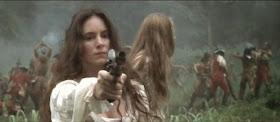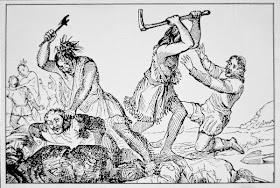I begin by introducing you to the second son of a pretentious prater-progenitor of the provenance of panic, Jean-Baptiste Hertel. Born in 1678 in the forest outpost of Trois-Rivières on the St. Laurence River, midway between the fortress of Quebec (above) and the trading station of Montreal, Jean-Baptiste had little choice but to be a warrior. In his distant motherland, the self absorbed Sun King, Louis XIV, was dissipating the treasures of France on European wars . Meanwhile, in the new world, dwarfed by the rapacious and prolific Protestant New England settlers to their south, and surrounded by the more numerous and often hostile Iroquois Confederacy, the Catholic people of “Canady” were left isolated and vulnerable.
Jean-Baptiste's father, Joseph Francis Hertel, raised his seven sons to follow the military and political strategy he had blazed – seemingly random and ruthless joint French and Indian raids descending without warning from the dark forests to burn English settler homes and mills and murder or kidnap the farmers, their wives and children. The French -Canadian objective was convince English settlers the frontier was too dangerous to claim, and to keep the English and the local tribes “irreconcilable enemies”, as the new Governor General of New France, Philippe Vaudreuil, put it..
And it worked. By the winter of 1704, when 34 year old Jean-Baptiste (above) set out to lead his first and most infamous raid, he was the best and brightest that New France had to offer the world, “An officer of great courage, but per-eminently cruel and vindictive.” In other words he was an effective and unapologetic terrorist.
Lieutenant Jean-Baptiste launched his first raid from the new wooden stockade at Fort Chambly (above), 15 miles south of Montreal, at the base of the falls on the Iroquois (aka Richelieu) River.
Early in the new year, Jean-Baptiste's forty-eight experienced local militia (including three of his brothers) along with 200 Abenaki, Iroquois, Wyandot, and Pocumtuc warriors paddled upstream, south, to Lake Champlain, then southward again along the eastern shore to the mouth of the Winooski River.
From here they marched on snowshoes one hundred miles to the southeast, up the Winooski Valley which cut through the Green Mountains. Their greatest obstacle would be the 30 mile leg over the final ridge separating them from the White River that ran east before joining the Connecticut River. Here they were joined by 40 Pennacook warriors, before making the 60 mile march, due south, toward the English settlement of Deerfield, 300 miles from Fort Chambly.
The community of Deerfield had been established forty years earlier by farmers seeking both the rich Connecticut Valley soil and the 100 miles distance from the Puritanical leadership of Cotton Mather's Massachusetts Bay Colony.
But in September of 1665, when the wagons baring the harvest paused just south of Deerfield to cross “Muddy Creek”, Indians attacked the stalled wagons, killing 90 men, stealing the horses, stealing or destroying the year's crop, and rechristening the stream as “Bloody Creek”.. Without food for the coming winter, the 200 residents were forced to abandon the town.
Back in 1704, 30 miles north of Deerfield, Lt. Hertel established a a cache of supplies for their return, just as his father, Joseph-Francis Hertel had done on that patriarch’s famous 1690 raid on Salmon Falls (above). In that predawn attack, 50 raiders (in old Cotton Mather's words, “Half Indianized Frenchmen, and half Frenchified Indians”) had dragged 35 English men, women and children from their beds and murdered them. And then burned the town to the ground.
The “raiders” had then marched 54 mostly women and children away as prisoners. Any who could not keep up were killed.
Once back in Canada the captives were divided up, and their fate depended on the whims of their new native masters. Prisoners that could later be ransomed from the Indians were the only bargaining chip New France had with New England. The terror attack which cost just two wounded men, made Joseph-Francis Hertel an official “Hero” in Quebec, and the governor applied to the Louis XIV to raise the family into the nobility. The only dark note for the French was that “Hero” Hertel was one of the wounded, and this would be his last raid.
The New Englanders reoccupied Deerfield in the 1690's. They repaired abandoned homes and built new ones, and strengthened the palisade in the center of town. Individual residents were still occasionally being killed by marauding warriors, so when, during late January of 1704 the 300 residents received word of a large raiding party spotted on Lake Champlain, 30 militiamen from the fishing villages of coastal Massachusetts were brought west to bolster the town's own 70 man militia force. But over the next month, the isolation, the cold, the snow and the long dark nights, bred complacency in the village and its guardians.
From their “cold camp” two miles north, Lieutenant Hertel made his final scout of Deerfield, noting the lax guards and the snow drifts left piled up against the northern wall of the stockade. It appeared the stage was set for Jean-Baptiste to better his father's 1690 triumph. An hour before dawn, Friday, 29 February, 1704, a handful of raiders used the drifts to clamber over the wooden walls and open the front gates, admitting invaders into the village's inner sanctum. At the same time, the Indian intruders burst into the outlying homes of other residents and began killing and destoying.
The new village minister, John Williams, was awakened as the Indian's burst into his home, “with axes and hatchets... to the number of twenty, with painted faces, and hideous acclamations. I reached...for my pistol...I...put it to the breast of the first Indian who came up, but my pistol missing fire, I was seized by 3 Indians who disarmed me, and bound me naked...(they then) fell to rifling the house...some were so cruel and barbarous as to...carry to the door two of my children (John Jr.,6, and an infant daughter, Jerushah) as also a Negro woman” ( his slave Parthena), and murder them. Perhaps the “barbarous” enemy were members of the Pocumtuc tribe, an entire innocent village of whom had been butchered, man, woman and child, by the New Englanders a few winters earlier.
The noise of the assault on the William's home had awakened the seven guards sleeping in the house next door. When the raiders attempted to rush that building the militia shot down at least one of the attackers, forcing them into a costly firefight.
The same confrontations were repeated inside the stockade, with the raiders suffering 2 Frenchmen and 9 Indians killed, and another 22 wounded, including Jean-Baptiste and one of his brothers. They had killed 39 villagers, and captured 112 prisoners. But the village remained, although almost half the homes had been burned, and reinforcements were rushing to their relief. Fitting the adult captives with snow shoes and carrying the younger children on their shoulders through the 3 foot deep snow, Lt. Hertel's wounded force began to limp back to Canada. Jean-Baptiste would now be forever known as “The Sacker of Deerfield”.
At least seven prisoners died within 48 hours – a male black slave murdered for sport by drunken Indians on the first night, two separate infants dashed against trees when the mothers could not keep up, two young girls and two adult women, including Reverend William's wife, all clubbed to death because they could not maintain the 12 miles a day demanded by the raiders. The raiders were forced to pause several times to bury their own, who had died from their wounds. In all, out of the 112 captives, 21 died and were murdered on the seven week long march back to Fort Chamby. French and Indian losses must have at least equaled that number.
Governor General Vaudreuil would try to put the best face on “The Deerfield Masacure”, but the raid proved to a political embarrassment for New France. The French could no longer simply blame the Indians for the cruel murder of so many women and children. And because of their high causalities, the native peoples proved difficult to recruit for another raid for a few years. Worse, the Indians were beginning to realize how valuable the English hostages were for their French partners, and their prices began to go up, which meant their profitability to New France went down.
Two years later 60 of the hostages, including Reverend Williams and four of his children, were returned to New England. William's youngest surviving child, Eunice, converted to Catholicism and was adopted into a Mohawk family. She, like many other of the younger children chose to stay in Canada. She wrote to her father, but never visited her brothers and sisters until after their father had died, in 1721. Eunice married a Mohawk man and together they raised four children.
The Reverend William's book on his captivity, co-written with Cotton Mather, became one of the best selling books in colonial America. Most of “The Redeemed Captive Returning to Zion” was an attack on Catholicism. Bu in post revolutionary America, those stories which dealt with William's Indian captors were borrowed by James Fenimore Cooper, and incorporated into that author's 1826 classic, “The Last of the Mohicans”
Jean-Baptiste Hertel never led another raid by himself, and within a few years was quietly assigned other duties. In 1713 he was finally promoted to Captain, but that was as far as he got. He died in 1721, just a month after his terrorist trainer, 80 year Joseph-Francois Hertel, also died. The acolyte of terror, his father's son, “The Sacker of Deerfield”, was just 54 years old, and offers a troubling hero for modern day French Canadians.
.






















No comments:
Post a Comment
Please share your reaction.